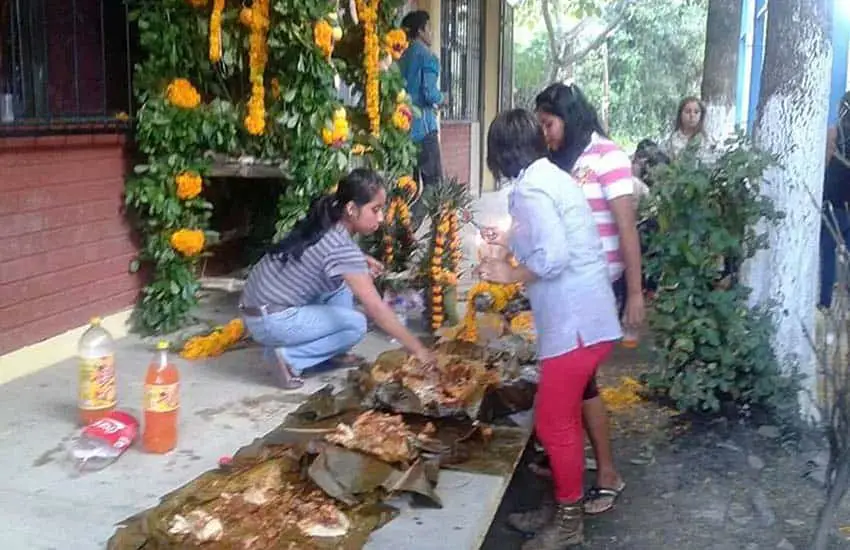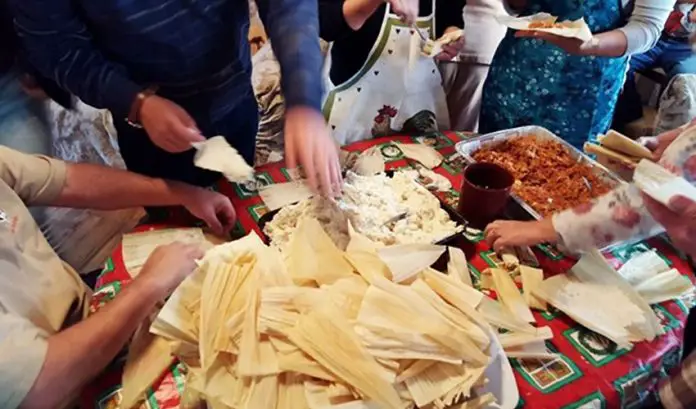The importance of tamales at this time of year crosses borders, as does the work of Mexico’s professional tamale researcher, Beatriz Ramírez Woolrich.
Granted, there is nothing that stops people from enjoying tamales year-round today in all kinds of social settings. Originally, however, in the Mesoamerican world, they were a food fit for the gods and eaten only by the elite during certain ceremonies, according to early colonial-era historian Bernardino de Sahagún.
Wheat, in the form of a communion wafer, became the sacred meal, but the tamale, whose name comes from the word for “wrapped” in Nahautl, remained important for the communal festivities after Mass, especially on holiday and is Mesoamerica’s oldest continuously-consumed food preparation.
Ramírez’s research concludes that there are at least 5,000 ways of preparing tamales in Mexico, as fillings, types of corn, cooking methods and wrappings vary immensely, depending on local foodstuffs. There are also regional and familial preferences that create variety as well.

Interestingly, Ramírez says, most Mexicans are not aware of many or most of the varieties outside their locale.
Until relatively recently, tamales made appearances generally on special occasion, because, as Ramírez says, “It’s not something you can make like a sandwich.”
Time and lots of coordinated hands are needed to make enough tamales so that it is worth the effort — like ravioli or meatballs.

With the advent of businesses making and selling tamales, the food has become more common, able to be purchased in relatively small quantities for events like baptisms and even casual business meetings. In Mexico City and other urban centers, they are very popular as a street food, with vendors found selling them early in the morning as a cheap breakfast on the go, often paired with the corn-based drink atole, and sometimes late at night. A few places have tamale preparations specifically for Day of the Dead and Holy Week.
But if one holiday is associated with tamales, it has to be the Christmas season. Mexicans all over the world value family and community get-togethers at this time of year. Various kinds of food can appear, and certainly tamales are not out of the equation, especially at potluck-type events.
These tamales may be the same type as seen the rest of the year, but they can be special in the sense that they are more often made completely from scratch.
Homemade tamales appear more often among rural and indigenous families and communities. In more urban settings, they compete with other preparations, especially on Christmas Eve and New Year’s Eve, when feasters often prefer Spanish-style bacalao, romeritos (a type of green vegetable) with mole sauce, pozole and, more recently, roast turkey and ham.
There is only one day a year when tamales are essential, and which day that is depends on which side of the border you are on.

In Mexico, tamales are required on the Catholic feast day of Candlemas, February 2, and it is not unusual for people to eat them more than once during the day. Candlemas is the Mexican Christmas season’s last hurrah: February 2 commemorates the presentation of Jesus at the temple, and after a mass and blessing, everything is packed away for the year.
Tamales figure in here starting on January 6. A sweet bread called a rosca de reyes (King’s Circle Cake) is shared among families, coworkers and gatherings of friends. The person who finds in their slice the small figurine of the Baby Jesus that’s been baked into the rosca slices are tasked with buying tamales for the same group on February 2.
North of the border, the tamale requirement has shifted to Christmas Eve or Christmas Day. The tamales are eaten as part of the turkey dinner.
Ramírez’s extensive research both north and south of the border indicates that this change comes from the greater importance of the Dec 24 and 25 in the United States, as well as the need of Mexican-American families to maintain their identity.
Ramírez says that in some ways, Mexican-American families are conserving the art of communally making tamales at home better than in Mexico because the process and storytelling that goes along with it — part of that conservation of identity. In the U.S., the need to eat tamales in the later part of the year is so strong that “Thanksgiving tamales” are gaining in popularity among Mexican-Americans.
The popularity of tamales north-of-the-border grew as the ingredients needed to make them became easier to get. Thirty years ago, it could be difficult to get just the right chili pepper or corn dough, with families sometimes sneaking them across the border.
Tamales’ popularity at this time of year is certainly helped by the fact that they are comfort food that retain heat well in cooler temperatures, often consumed with hot drinks like atole or fruit-based ponche (a hot fruit punch drink). But both inside and outside of Mexico, the eating of tamales made at home may have a difficult time surviving.
Modern life in both countries generally does not afford a family the luxury of spending a day together making batches of them. And Mexican-Americans may not have a grandmother from the old country to guide everyone through the process.
For this reason, tamales’ holiday role in many places has become limited to sharing a batch brought from the group’s favorite maker — the person who makes them “just like grandma did.” This is not such a new idea.
Ramírez’s interest in tamales stems in large part from growing up some decades ago around her mother’s business, which made and sold tamales all over Mexico City. Such makers now are many and do well in major cities in Mexico, but the demand is even stronger in the US, where makers often cannot keep up.
Leigh Thelmadatter arrived in Mexico 18 years ago and fell in love with the land and the culture in particular its handcrafts and art. She is the author of Mexican Cartonería: Paper, Paste and Fiesta (Schiffer 2019). Her culture column appears regularly on Mexico News Daily.
